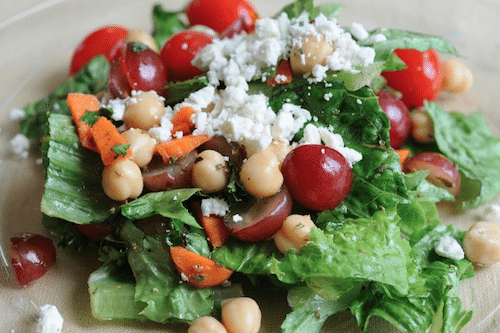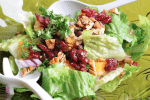Fall in Love with Salad
 Salads make simply fantastic meals. They are chock-full of nutrients and flavor, and -- when prepared thoughtfully -- they can be low in calories but still very satieting. Today we'd like to celebrate salad with a guide to its preparation, presentation, and transportation.
Salads make simply fantastic meals. They are chock-full of nutrients and flavor, and -- when prepared thoughtfully -- they can be low in calories but still very satieting. Today we'd like to celebrate salad with a guide to its preparation, presentation, and transportation.
Salad Preparation Guide:
Salad:
 Think about what you want from your salad. How filling does it need to be? What elements are especially important to you? Do you have fresh veggies that you are dying to try?
Think about what you want from your salad. How filling does it need to be? What elements are especially important to you? Do you have fresh veggies that you are dying to try?- Include a variety of textures. For example, crisp lettuce, crunchy toasted pecans, creamy lowfat bleu cheese, and carrots work very well together.
- Play with flavors and make sure the salad has some contrast. For example, pair tangy dressing with mild veggies, or bring both sweet and salty elements to the mix.
- Use a variety of colorful vegetables. To add staying power, include some lean protein (like chicken breast, beans, or tuna fish) and whole grains (like rice or quinoa).
- Chop the elements of your salad into bite-size pieces. This makes actually eating your salad a less daunting affair.
Dressing:
- Try simple pieces of fresh citrus fruits and squeeze them over your salad.
- Play around with flavored oils and vinegars. Remember to keep the levels of oil very low -- 1-2 tsp is a good serving size.
- Give spritz bottles of dressing a try. These allow you to lightly coat the elements of your salad with dressing and still avoid turning the whole thing into a calorie bomb.
- Mix nonfat yogurt and vinegar for a fast and creamy dressing.
- Top your salad with a bit of balsamic glaze. You can buy glazes in the store, or make your own by cooking balsamic vinegar over low heat until you get a thick sauce.
Salad Presentation Guide:
 Go Wide – Using a big plate helps the salad spread out, which makes it easier to offer a wide variety of healthful toppings. These platters are perfect for a party or family meal.
Go Wide – Using a big plate helps the salad spread out, which makes it easier to offer a wide variety of healthful toppings. These platters are perfect for a party or family meal.- Stand Tall – When making an individual salad, think tall. Tall could mean piling leafy greens in a high, airy stack. It can also mean filling a ramekin or bowl that is taller than it is wide. For a new twist, layer chopped veggies in a tall glass. It's an unforgettable presentation!
- Be Creative – To add another layer of visual interest to your salad, try presenting it on patterned bowls, plates, dishes, or ramekins. Or let the ingredients shine by piling them onto a white plate.
Salad Transportation Guide:
Sometimes you just don't have time to sit down and eat a salad at home. For those moments that require salad on-the-go, try this handy guide...
- Place some oil and vinegar in the bottom of a zip lock bag.
- Add lettuce and plenty of vegetables to your bag.
- Top with whatever seasoning elements you want to add -- herbs, seeds, etc
- Seal the bag and place in an insulated container for transport.
- When you're ready to eat the salad, give the bag a good shake and pour the contents onto a plate.
Want more information about salad? Check out our Nutrition Education Store! It's filled with fantastic resources like cookbooks, handouts, presentations, posters, and more!


